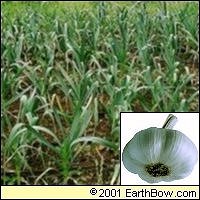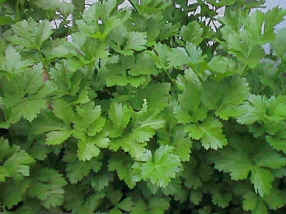|
Garlic |
|
Garlic |
By Frances Albrecht, M.S., C.N.
For thousands of years, the "stinking rose," as garlic is affectionately called, has been eulogized for its myriad healing effects. Five-thousand-year-old Sanskrit records cite the therapeutic use of garlic. Greek physician Hippocrates recorded numerous uses for the pungent herb, while documents and stories from around the world affirm garlic's time tested usefulness as an antibacterial, antifungal and antiviral agent used traditionally to treat everything from dandruff to diphtheria, fevers to swelling.
Perhaps the most amazing use of garlic was in France in 1721, when four condemned criminals were given the unsavory task of burying plague victims. Surprisingly, none was stricken by this deadly disease, a feat attributed to their consumption of macerated garlic soaked in wine. Four Thieves Vinegar, the name given to this tonic, is still sold today in France.
Garlic (Allium sativum) is a member of the lily family and is cultivated around the world. This hearty herb contains an array of naturally occurring chemicals; it's still unclear which ones are responsible for garlic's diverse effects. Whole, the bulbs bear little odor. However, upon grinding or chopping, the enzyme alliinase is released, activating the conversion of garlic's sulfur containing amino acid allicin to the odorous allicin. This sulfurous volatile is believed responsible for exerting the strongest pharmacological effects of the plant.
One study found that five sulfur compounds from aged garlic extract showed approximately 1,000 times more potent antioxidant activity than the whole aged garlic extract, according to Robert McCaleb, president of the Herb Research Foundation (HerbalGram, 1993, vol. 29).
Allicin also increases the levels of two naturally occurring antioxidant blood enzymes, catalase and glutathione peroxidase. These antioxidant enzymes form our front line of defense against damaging free radicals such as those found in cigarette smoke, car exhaust and other pollutants.
Garlic also contains detectable amounts of germanium and selenium, believed to play a role in garlic's antitumor effects.
Cloves for Your Heart
Garlic exerts many disease-preventive effects in the blood. It inhibits blood platelet aggregation, making the blood less "sticky," thereby reducing risk of blood clot and plaque formation in blood vessels. Excessive platelet aggregation has been linked to heart disease and strokes.
 Garlic has also been shown to reduce blood cholesterol levels. In one double-blind study performed
with 261 German patients with high blood cholesterol, 16 weeks of treatment with 800 mg. per day
(the equivalent of one garlic clove) of standardized garlic powder resulted in a 12 percent
reduction in total cholesterol and a 17 percent decrease in triglycerides (Arzneimittelforschung,
1990, vol. 40). Other studies have shown similar results.
Garlic has also been shown to reduce blood cholesterol levels. In one double-blind study performed
with 261 German patients with high blood cholesterol, 16 weeks of treatment with 800 mg. per day
(the equivalent of one garlic clove) of standardized garlic powder resulted in a 12 percent
reduction in total cholesterol and a 17 percent decrease in triglycerides (Arzneimittelforschung,
1990, vol. 40). Other studies have shown similar results.
Besides lowering cholesterol levels, garlic may also provide protection from free radical-induced oxidation of cholesterol, thereby reducing the risk of atherosclerosis (deposition of fatty substances along the inner layer of the arteries). One study conducted at the University of Kansas Medical Center showed that taking six 100 mg. capsules of garlic powder per day reduced the oxidation of low density lipoprotein (LDL) cholesterol by 34 percent.
Similarly, in another study, 10 volunteers were asked to eat a fatty meal containing 100 grams of butter either alone or with the juice of 50 grams of garlic. After three hours, the mean blood cholesterol levels of the treated group were 7 percent below baseline compared to the untreated group, which were 7 percent above baseline value—a significant change (Lancet, 1973, vol. ii).
Studies also show garlic has the ability to reduce blood pressure. In several studies completed in Europe between 1988 and 1990, small doses of dried garlic powder were ingested by subjects who then experienced a drop in blood pressure of 5 to 10 percent over several weeks. Drop in blood pressure is probably due to garlic's known effects on the body's hormone-like prostaglandins, which control the tightening and loosening of blood vessels.
Population studies from around the world show that an inverse relationship exists between cancer rates and garlic consumption; in areas where consumption of garlic (and onions) is high, cancer rates are generally lower. Likewise, in animals garlic extracts and allicin preparations have shown antitumor activity. In humans, garlic has been shown to inhibit the formation of cancer-causing nitrosamines, which are formed during digestion from the food preservatives nitrites and nitrates.
Garlic's Antibacterial Abilities
Garlic has been used for centuries as an antiseptic and antibacterial agent. During World War II garlic preparations were used to treat wounds. More recently, laboratory studies show that garlic preparations are effective against many forms of bacteria including the common staphylococcus, streptococcus, E. coli and salmonella bacteria, proving that garlic exerts antibiotic activity (Med. Hypothesis, 1983, vol. 12).
In addition, garlic is particularly useful as an antifungal agent. Some studies have shown its inhibition of candida albicans, a common yeast, is even more potent than such antifungal agents as gentian violet and the prescription drug nystatin (Mykosen, 1980, vol. 23). Diabetics, who tend to develop yeast infections because yeast thrives in a high-sugar environment, may find garlic particularly useful.
Not only does garlic help kill yeast, it can also lower blood sugar. The active principles are believed to be allyl propyl disulphide (APDS) and diallyl disulphide oxide (allicin), although other constituents such as flavonoids may play a role as well.
Experimental and clinical evidence suggests that APDS lowers glucose levels by competing with insulin (also disulphide protein) for insulin-inactivating sites in the liver. This results in an increase of free insulin. APDS administered in doses of 125 mg. per kilogram of body weight to fasting humans causes a marked fall in blood glucose levels and an increase in serum insulin. Allicin doses of 100 mg/kg produce a similar effect, according to Michael Murray, N.D., and Joseph Pizzorno, N.D., in Encyclopedia of Natural Healing (Prima).
Garlic's healing properties seem boundless. It's proven useful as an anti-inflammatory agent, a diuretic, an expectorant, an antinausea and digestive aid, and has been used to treat colic, indigestion and flatulence. New reports show that garlic may even exhibit an antioxidant effect on the brain, protecting neurons from oxidant destruction and guarding against senility.
Convinced of garlic's amazing virtues but still put off by its odor? Don't despair! Now, even those discouraged by garlic's distinct aroma can take advantage of the many deodorized garlic remedies available at your natural products store. While fresh garlic remains a shopper's bargain, garlic supplements contain most of the same beneficial chemical compounds, without offending. Garlic supplements also share a broad base of testing and research and are widely used in Japan, the United States and Germany, where garlic pills are best-sellers.
Frances Albrecht is president of Nutrition Education Services and is a Distance Learning Instructor at Bastyr University. You can visit Bastyr's World Wide Web site at http.//www.bastyr.edu or point your browser to http://www.healthcraze.com for more information on the healing powers of garlic.
This story is produced through the Bastyr University Health Information Project, funded by INDENA, U.S.A., raw material suppliers of standardized herbal extracts. Bastyr University offers a program in naturopathic medicine (N.D.); bachelor's degrees in the natural health sciences; and master's degree programs in nutrition, acupuncture and Oriental medicine. For information, contact Bastyr University, 144 NE 54th St., Seattle, WA 98105; 206-523-9585.
Reprinted with permission from the July 1996 issue of Delicious! Magazine, a publication of New Hope Communications, Boulder, CO.

Parsley